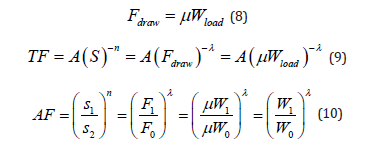Impact Factor : 0.548
- NLM ID: 101723284
- OCoLC: 999826537
- LCCN: 2017202541
Seongwoo Woo1*, Dennis L ONeal2, Yimer Mohammed Hassen1, Gezae Mebrahtu1 and Hadush Tedros Alem1
Received: March 09, 2024; Published: March 19, 2024
*Corresponding author: Seongwoo Woo, Manufacturing Technology, Mechanical Technology, Ethiopian Technical University, Addis Ababa, Ethiopia
DOI: 10.26717/BJSTR.2024.55.008728
To raise the fatigue life of mechanical product such as freezer drawer, parametric Accelerated Life Testing (ALT) as systemtic strategy is submitted, caused by life–stress prototype and sample size.This planned procedures permit designer to reveal the constructional fault that has a remarkable outcome on system reliability. Eventually, enterprise shall bring to stop recalls from the field. As a test occasion, raising the lifetime of product operated by machinery such as Freezer drawer was scrutinized.
Keywords: Mechanical Product; Parametric ALT; Freezer Drawer; Fatigue; Design Defects
The system operated by machinery carries (created) power to reserve a schemed consequence which involves forces & movement and acquires mechanical advantages by rightly achieving unspecified mechanisms. For example, by implementing the refrigerating cycle, a refrigerator permits chilled air from evaporator (heat exchanger) to freezer & refrigerator department. So, stored refrigerator foods may be freshly maintained. Refrigerator should be conceived to correctly function under the circumstances really utilized by the customer. When there are design deficiencies in the construction, it shall not instantly operate in its assumed life (Figure 1). As unexpectedly observing it by reliability tests, a designer shall devise it in the nearly all effective strategy [1]. It detains:
a) An ALT programme
b) Load scrutiny
c) An ALTs with some modifications
d) The action of making a judgment if product attains the achieved BX lifetime. As a case study, the mechanical systems such as Freezer drawer will be investigated.
Responding for the Schrodinger’s differential mathematical problem may be expressed:

Linear transport may be described:

For a particular event, solid-state diffusion, J, can be shortened

When Equation (3) sets the inverse, the life-stress (LS) protype shall be described:

The


To reach the acceleration factor (AF), proclaimed as the relation between the accelerated stress and usual stress, AF shall be stated as:

To attain the assigned cycles for goaled lifetime - B1 lifetime of ten years, sample size integrated with Equation (6) can be stated as [2]:

As a capacity of the refrigerator, consumer wants to use the drawer to keep the stored food fresh. To meet these expectations, the refrigerator drawer is conceived to hold the indispensable food weights over predicted end-user situations in product life. Reserving food in the drawer therefore has the repeatedly handling ways:
i. Opening the Freezer drawer to reserve food,
ii. Grapping the stored food, and
iii. Closing it.
The important structural parts have as follows:
1. Handle,
2. Drawer box,
3. Slide rail, and
4. Pocket box (Figure 2).
From the field, as load is repeatedly applied, some parts in the Freezer drawer had been failing because of undisclosed product defects. As a result, consumer requests the problematic products to replace them. To work it for anticipated life, the design defects of Freezer drawer may be observed and revised by parametric ALT (Figure 3). In Figure 4, the force balance of the drawer from the free-body diagram may be described as:

For the refrigerator drawer, the functioning (or environment) situations are 0–430C and humidity spreading from 0 to 95 percent with 0.2–0.24 g’s acceleration. In the US, the working of the drawer depends on end-user use. Market statics indicated that end-user operated the Freezer drawer between five and nine cycles per day. With design lifetime for ten years, drawer occurred 36,500 use cycles. For the worst occasion of the food load, the needed force was 0.34 kN (35 kgf) on the drawer handle. The exposed food load for the ALT was 0.68 kN (70 kgf). With an accumulative factor, λ, of 2, AF in Equation (10) was 4.0. To attain the lifetime goal – B1 lifetime of ten years, if the shape parameter, b, was assumed to be 2.0, the mission cycles for three samples calculated in Equation (7) were 67,000 cycles. As an outcome, the troublesome design of drawer system shall be found and revised.
In 1st ALT, the drawer handle in the refrigerator cracked and fractured at 7,000 cycles and 8,000 cycles (Figure 5). As the problematic handles from the 1st ALT and the field were cautiously investigated, there were design defects — inadequate attached area of drawer handle. That is, as exposed to repetitive food weights, these design flaws in the drawer handle could create to instantly be removed. To cease the fractured handle from the Freezer drawer, the Freezer handle was changed:
1. Enlarging the wideness of the strengthened handle, C1, from 90mm to 122mm;
2. Enlarging the hooker size in handle, C2, from 8mm to 19mm.
In 2nd ALT, the 10mm gap between the drawer and the Freezer compartment was found at 15,000 cycles and 16,000 cycles. As they were disassembled, component of slide rails in the Freezer drawer cracked and fractured. That is, as the food load for parametric ALT was repetitively loaded, it was exposed that the slide rails were fragile because of their insufficient strength. These fractured rails came from the corner shape of the rails. As a result, the rail occurred to be cracked and fractured to its end. As action plans, the rail was modified:
1. Enlarging the fastening screws, C3, from 1 to 2;
2. Fastening the inner chamber and modifying material, C4, from HIPS to ABS;
3. Becoming thicker for the boss, C5, from 2.0mm to 3.0mm;
4. Fastening a new support rib, C6. By applying the ALT, the design of troublesome slide rail was changed (Figure 6).
When the designs in the structure were modified, the refrigerator drawer can do to reach the goaled lifetime – B1 lifetime of ten years – because of no concerns till 67,000 cycles.


